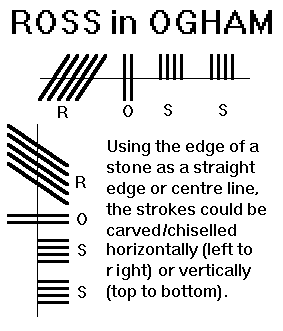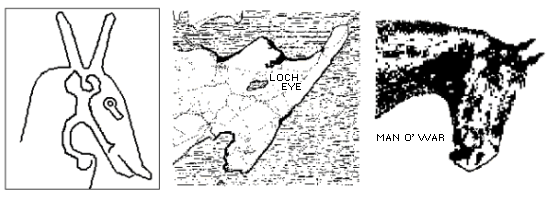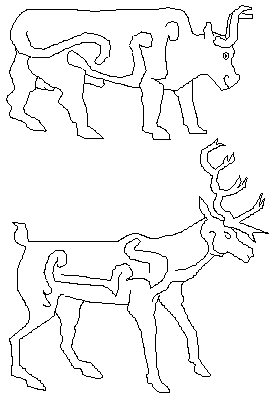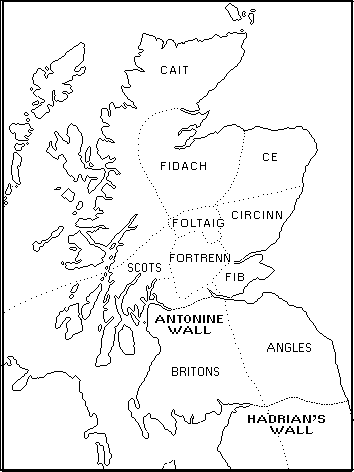 I - PICTS IN THE LAND OF ROSS It is generally accepted that the Pictish people migrated to the British Isles from central Europe about 1,000 years before Christ during the Bronze Age. They spoke a mixture of languages which are categorized as a P-Celtic Pictish and a ritualistic or symbolic Pre-Celtic Ogham. P-CELTIC PICTISH: The picts had an oral tradition for keeping historical tales, stories and laws alive. Everything was committed to memory. The one exception was a list of 70 kings written in a document known as "The Pictish Chronicle". This language for use in general speech is linked with the Brythonic language of southern England, Welsh, Cornish, and Breton. St. Columba's biographer stated that the Irish saint, speaking the Q-Celtic Gaelic, needed a translator to preach to the Pictish King Brude, son of Maelcon, during the late 6th century at Brude's court near the shores of Loch Ness. [Over 28 early kings are identified with the words "Brude" or "Bridei". There is a temptation to conclude that "Brude" is simply the Pictish word for King.]   PRE-CELTIC OGHAM:
PRE-CELTIC OGHAM:Ogham [pronounced ohm] is strongly pre-Celtic and non Indo-European. An analysis of the "beth luis nion", their "alphabet", which was based upon the names of 20 plants [mostly trees], indicates that the Rhine River valley best represents the area where the plants of the Ogham existed. The letters consist of from one to five parallel straight strokes in four different sets; these could be easily chiselled or cut into stone, bone or a wooden stick. Since there was no letter "P" in Ogham, the people could not have named themselves "Picts". Inscriptions, dating from the 4th century to the 9th century AD, on more than 32 Symbol Stones in Scotland [mainly in Easter Ross], are chiselled in the Pictish Ogham language together with carvings of geometric or animal forms until the 8th century, when Christian motifs are introduced [just in time for raids by the Vikings who had not yet been converted to Christianity].  THE LAND OF ROSS:
THE LAND OF ROSS: According to my professor of German (Dr. R. Arnold) at Victoria University, the ancient German (Teutonic) language had a phrase "Ross und Ritter", which roughly translated as "noble steed and rider". Note the horse from a Pictish Symbol Stone, the shoreline of Easter Ross with Loch Eye in place, and a picture of Man o' War. As skillful sea-farers, I suggest that the Picts used the word "Ross" to describe the land's coastline and that it may have been borrowed by the Scots as a more generalized term (promontory). (E.g.- The English "curfew" came from a French phrase meaning to "cover the fire". Over the years, it has developed into a word with a different significance.) The developing languages of the neighbouring cultures influenced each other. Since my early notes about "Ross und Ritter", I have learned that the word horse appeared as hors in Old English (c. 825) as well as in Old High German, the oldest Teutonic forms and Norse. The modern Dutch, like the cockneys, call it ors, and I must point out that the Teutonic word begins with an aspirate h - - - pronounced exactly like ors. It is no co-incidence that these three letters are found in the name Ross.  SYMBOL STONES:
SYMBOL STONES: Today, the Picts are acclaimed for their symbol stones. Nowhere in Scotland are these more concentrated than in Easter Ross and the Black Isle. The earliest incised stones at Rosskeen, and Nonakiln near Invergordon date from the 5th or early 6th century. Masterpieces of the 7th and 8th centuries exist at Nigg, Shandwick and Hilton of Cadboll. Others followed at Kincardine, Edderton and Tarbat. Samples may be found at Aberlemno, Portmahomack, Rosemarkie, Strathpeffer and Dingwall. Many have been removed to museums, such as Dunrobin Castle, Golspie, Inverness and the National Museum of Scotland. Together, they indicate that Easter Ross definitely formed the very strong heartland of a major sub-kingdom. They also demonstrate the wealth and vigour of a once fluourishing Pictish nation as it was nearing its end. THE ORIGIN-LEGEND OF THE PICTS: The first section (De Situ Albanie) of the Pictish Chronicle of Kings indicates that the people were named after their king, Cruithne, the son of Cinge, who ruled for 100 years. The Irish version of the "Historia Britonum" gives Cruithne a genealogical pedigree traced all the way back to Noah, as follows: Cruithne, son of Cinge, son of Luchtain, son of Parrthalan, son of Agnoinn, son of Buain, son of Mais, son of Fathecht, son of Jafeth, son of Noe.  The seven principal divisions of ancient Alba were named after Cruithne's seven sons: Fib, Fidach, Foltaig/Fodla, Fortrenn/Fortriu, Cait, Ce and Circinn/Cirigh.
The seven principal divisions of ancient Alba were named after Cruithne's seven sons: Fib, Fidach, Foltaig/Fodla, Fortrenn/Fortriu, Cait, Ce and Circinn/Cirigh.Cait, meaning "cat", ruled Caithness, Sutherland, the Western Highlands and islands. Wild life included the wolf, Red deer, serpents, wild cattle, falcons, eagles, wild boars. Even large cats were known to live in remote areas of the far north of Scotland in the first century A.D. Fidach, the "Woodsman", ruled over Moray, Nairn and Ross for forty years. Ce ruled for fifteen years over Banff, Buchan and parts of Aberdeenshire. Foltaig ruled Athol and Gowrie. The areas now known as Angus and Mearns were governed by Circinn, the "crest-headed". Fortrenn is said to have had a lengthy reign over Strathearn and Menteith. Finally, Fib ruled what is known today as Fife and Kinross. Obviously, everything previously stated is little more than an origin myth. Since the P-Celtic Pictish language had no native words beginning with the sound [f], it is reasonable to assume that most of the above figures are pure fiction and invented by the Gaelic Scots. Nevertheless, fables add interest to our story, and sometimes there are tiny grains of truth which develop their own historical momentum. The number "7" seems to have had a magical or mystical significance. Historically, there would be the seven pairs of districts governed by sub-kings or Righs under the Head King or Ardh-Righ. Some accounts refer to the "seven maister men" who were persons of great importance during the transition from Alba to Scotland. --------------- REFERENCES: Chapter I of John Prebble's Lion In The North (Secker and Warburgh, London, 1971) is always a good place to start.(See NOTE 2 below.) We also thank him for writing the Preface to Our Ross Family Story in a letter dated July 23, 1978. If you are patient and have a strong constitution, use key words or phrases (e.g. "P-Celtic Pictish", "Ogham", "The Pictish Chronicle", "The Pictish Trail", etc.) on INTERNET SEARCHES. Be prepared for some mixed results. One web-site suggested that Ogham was an Irish invention, but since Ogham has signs for h and z that would seem to stretch the facts; the Irish did add 5 letters to the original Ogham for their own purposes. Another source, suggesting an Etruscan or a Basque origin for the P-Celtic Pictish language, seemed to have the advertising of art shops and travel agencies as barely hidden agendas. Some of the better internet websites of the late 1990's are maintained, produced or sponsored by F. Lennox Campello, J. Curtis Clark, The Glenmorangie Distillery Company, Highlander Web Magazine and Scotweb's Scottish History Magazine. Robert M. Gunn referred to "giant sabre tooth cats" from which Caithness received its name, but he has backed away from the legendary existence of the felid line of Machairodontinae since these would have been extinct at the end of the Pleistocene era ... and definitely not alive in the first century AD. Still, his comments about "large cats in remote areas" leaves an opening to the possibility that descendants of the Nimravinae line might have been around. [NOTE 1: When visiting Easter Ross and the Black Isle, the tourist would be well advised to enquire about "The Pictish Trail", and to obtain further information about the Picts from any information board at one of the sites named in this story.] [NOTE 2: John Prebble, on page 114 of this book, also notes that Pictish-Celtic tradition was deeply ingrained in the Declaration of Arbroath, which "set the will and the wishes of the people above the King. Though they were bound to him 'both by law and by his merits' it was so that their freedom might be maintained. If he betrayed them he would be removed and replaced. This remarkable obligation placed upon a feudal monarch by his feudal subjects may be explained in part by the fact that Bruce was still a heather king to many of them, still a wild claimant ruling upon sufference and success. But the roots of his kingship were Celtic, and a Celtic tradition was here invoked, the memory of the Seven Earls, the Seven Sons of Cruithne the Pict in whom, it was believed, had rested the ancient right of tanistry, the elevation of kings by selection. This unique relationship of king and people would influence their history henceforward, and would reach its climax in the Reformation and the century following, when a people's Church would declare and maintain its superiority over earthly crowns."] |





